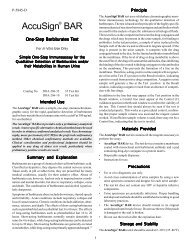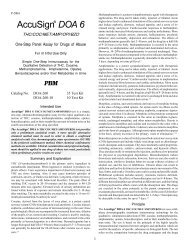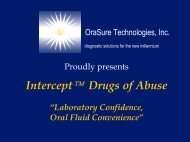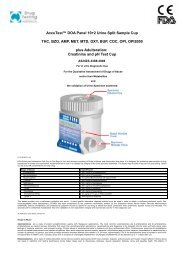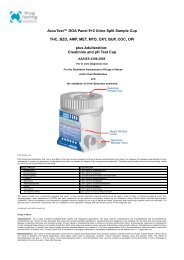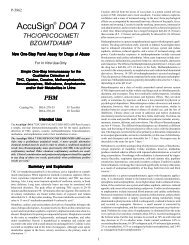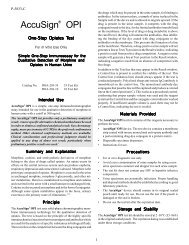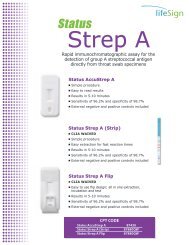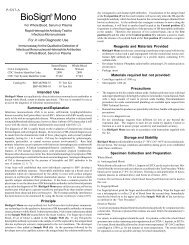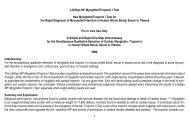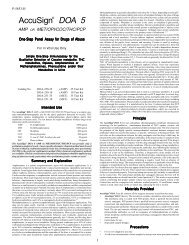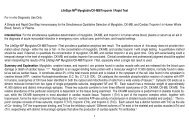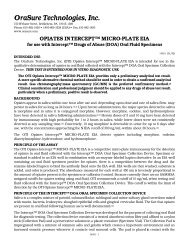AccuSign® BZO - Drug Testing
AccuSign® BZO - Drug Testing
AccuSign® BZO - Drug Testing
You also want an ePaper? Increase the reach of your titles
YUMPU automatically turns print PDFs into web optimized ePapers that Google loves.
P-5846-D<br />
AccuSign ®<br />
<strong>BZO</strong><br />
One-Step Benzodiazepines Test<br />
For In Vitro Use Only<br />
Simple One-Step Immunoassay for the<br />
Qualitative Detection of Benzodiazepines<br />
and/or their Metabolites in Human Urine<br />
Catalog No. DOA-207-35 35 Test Kit<br />
DOA-207-10 10 Test Kit<br />
Intended Use<br />
AccuSign ® <strong>BZO</strong> is a simple, one-step immunoassay intended for<br />
use in the qualitative detection of benzodiazepines in human urine<br />
with a cutoff at 300 ng/mL for oxazepam.<br />
The AccuSign ® <strong>BZO</strong> test provides only a preliminary analytical<br />
result. A more specific alternative chemical method must be used<br />
in order to obtain a confirmed analytical result. Gas chromatography,<br />
mass spectrometry (GC/MS) is the preferred confirmatory<br />
method. Other chemical confirmatory methods are available.<br />
Clinical consideration and professional judgment should be<br />
applied to any drug of abuse test result, particularly when<br />
preliminary positive results are used. 1<br />
Summary and Explanation<br />
Benzodiazepines are a class of frequently prescribed central nervous<br />
system (CNS) depressants which include widely used drugs<br />
such as chlordiazepoxide, diazepam, and oxazepam. They have<br />
medically useful properties, including antianxiety, sedative, anticonvulsant,<br />
and hypnotic effects. 2 They are taken orally or sometimes<br />
by injection, and have a low potential for physical or<br />
psychological dependence. Benzodiazepines induce drowsiness<br />
and muscle relaxation. Their use can also result in intoxication,<br />
similar to drunken behavior except without evidence of alcohol<br />
use, and the loss of inhibitions. Chronic abuse can result in<br />
addiction and tardive dyskinesia (involuntary muscle movements<br />
of the face, limbs, and trunk). Overdose can result in coma and<br />
possible death. Withdrawal syndrome includes anxiety, insomnia,<br />
tremors, delirium, and convulsions.<br />
The effects of benzodiazepine last 4–8 hours. The different benzodiazepines<br />
are absorbed at different rates, and the timing of their<br />
psychoactive effects varies with the absorption rate. The drugs are<br />
excreted in the urine primarily as the parent compounds or as<br />
oxazepam glucuronide, an inactive metabolite (in the case of<br />
chlordiazepoxide and diazepam) and are detectable for 1–2 days.<br />
Oxazepam is detectable in the urine for up to 7 days. 2,3 1<br />
Principle<br />
The AccuSign ® <strong>BZO</strong> test uses solid-phase chromatographic membrane<br />
immunoassay technology for the qualitative detection of<br />
benzodiazepine. The test is based on the principle of the highly<br />
specific immunochemical reactions between antigens and antibodies<br />
which are used for the analysis of specific substances in<br />
biological fluids. The test relies on the competition between the<br />
drug conjugates and the drugs which may be present in the urine<br />
sample, for binding to antibodies. In the test procedure, a sample of<br />
urine is placed in the Sample well of the device and is allowed to<br />
migrate upward. If the drug is present in the urine sample, it<br />
competes with the drug conjugate bound to the dye, for the limited<br />
antibodies immobilized on the membrane. If the level of drug or<br />
drug metabolite is above the cutoff level, the drug will saturate the<br />
antibodies, thus inhibiting the binding of the dye coated with drug<br />
conjugates to the antibodies on the membrane. This prevents the<br />
formation of a line on the membrane. Therefore, a drug-positive<br />
urine sample will not generate a line at Test (T) position in the<br />
Result window, indicating a positive result from positive drug<br />
competition. A negative urine sample will generate a line at Test<br />
position in the Result window, indicating a negative result from an<br />
absence of competition with free drugs.<br />
In addition to the line that may appear at the Test position in the<br />
Result window, a Control line must appear at the Control (C)<br />
validation position in the Result window to confirm the viability of<br />
the test. This Control line should always be seen if the test is<br />
conducted properly. This works as a procedural control, confirming<br />
that proper sample volume was used and the reagent system<br />
worked. If insufficient sample volume is used, there may not be a<br />
Control line, indicating that the test is invalid.<br />
Materials Provided<br />
The AccuSign ® <strong>BZO</strong> test kit contains all the reagents necessary to<br />
perform the tests.<br />
• AccuSign ® <strong>BZO</strong> device. The test device contains a membrane<br />
strip coated with polyclonal anti-benzodiazepine antibody and<br />
a pad containing drug-dye conjugate in a protein matrix.<br />
• Disposable specimen dispensers.<br />
• Instructions for use.<br />
Precautions<br />
• For in vitro diagnostic use only.<br />
• Avoid cross contamination of urine samples by using a new<br />
urine specimen container and dropper for each urine sample.<br />
• The test kit does not contain any HIV or hepatitis infective<br />
components.<br />
• Urine specimens are potentially infectious. Proper handling<br />
and disposal methods should be established according to good<br />
laboratory practices.<br />
• The AccuSign ® device should remain in its original sealed<br />
pouch until ready for use. Do not use the test if the pouch is<br />
damaged or the seal is broken.<br />
• Do not use the test kit after the expiration date.
Add 3 drops<br />
(110 µL)<br />
Read in<br />
3–10<br />
minutes<br />
<strong>BZO</strong><br />
C<br />
T<br />
S<br />
OR<br />
CONTROL (VALIDATION) LINE (C).<br />
The Control/Validation line indicates:<br />
1. If the proper amount of sample was used;<br />
2. If the sample wicked;<br />
3. If the procedure was followed properly.<br />
If no control line appears, the test is NOT VALID.<br />
Repeat the test using a new device, and follow the<br />
procedure carefully.<br />
C<br />
T<br />
C<br />
T<br />
C<br />
T<br />
S<br />
T<br />
C<br />
<strong>BZO</strong><br />
<strong>BZO</strong> (–) <strong>BZO</strong> (+)<br />
INVALID<br />
Negative (–) = Control line and Specific <strong>Drug</strong> line<br />
Positive (+) = Control line only; No Specific <strong>Drug</strong> line<br />
Storage and Stability<br />
The AccuSign ® <strong>BZO</strong> test kit should be stored at 2–30°C (35–86 ° F)<br />
in the original sealed pouch. The expiration dating was established<br />
under these storage conditions.<br />
Specimen Collection and Preparation<br />
Approximately 110 µL of urine sample is required for each test.<br />
Fresh urine specimens do not require any special handling or<br />
pretreatment. Specimens should be collected in a clean glass or<br />
plastic container. If testing will not be performed immediately,<br />
specimens should be refrigerated (2–8°C) or frozen. Specimens<br />
should be brought to room temperature before testing.<br />
Specimens containing a large amount of particulate matter may<br />
give inconsistent test results. Such specimens should be clarified<br />
by centrifuging or allowing to settle before testing.<br />
Test Procedure<br />
The test procedure consists of adding the urine sample to the<br />
Sample well of the device and watching for the appearance of<br />
colored lines in the result window.<br />
Test Protocol<br />
1. For each test, open one AccuSign ® <strong>BZO</strong> pouch<br />
and label the AccuSign ® device with the patient<br />
ID.<br />
2. Holding the dropper vertically, dispense 3 drops<br />
(110 µL) of the urine sample into the Sample well<br />
(S).<br />
3. Read the result after 3 minutes, but within 10<br />
minutes of sample addition.<br />
Interpretation of Results<br />
Negative: The appearance of a reddish-purple Control line (C)<br />
and a line next to T indicates a negative test result; i.e., no drug<br />
above the cutoff level has been detected. The color intensities of the<br />
Control line and the Test line may not be equal. Any faint line in the<br />
Result window, visible in 10 minutes, should be interpreted as<br />
negative. A negative test result does not indicate the absence of<br />
drug in the sample; it only indicates the sample does not contain<br />
drug above the cutoff level in qualitative terms.<br />
Positive: The appearance of only a reddish-purple Control line<br />
and no distinct line next to T indicates the test result is positive for<br />
<strong>BZO</strong> (i.e., the specimen contains <strong>BZO</strong> at a concentration above the<br />
cutoff level). A positive test result does not provide any indication<br />
of the level of intoxication or urinary concentration of the drug in<br />
the sample; it only indicates the sample contains drug above the<br />
cutoff level in qualitative terms.<br />
Invalid: A distinct Control line (C) should always appear. The<br />
test is invalid if no Control line forms at the C position. Such tests<br />
should be repeated with a new AccuSign ® <strong>BZO</strong> test device.<br />
Limitations<br />
• The test is designed for use with unadulterated urine only.<br />
• There is a possibility that factors such as technical or procedural<br />
errors, as well as other substances in the urine sample<br />
which are not listed in Table 3 below, may interfere with the<br />
test and cause erroneous results.<br />
• Adulterants, such as bleach and/or alum, in urine specimens<br />
may produce erroneous results. If adulteration is suspected, the<br />
test should be repeated with a new sample.<br />
• The test result read after 10 minutes may not be consistent with<br />
the original reading obtained within the 10 minute reading<br />
period. The test must be read within 10 minutes of sample<br />
application.<br />
2
User Quality Control<br />
Internal Control: Each AccuSign ® test device has built-in controls.<br />
The Control line is an internal positive procedural control. A<br />
distinct reddish-purple Control line should always appear at the C<br />
position, if the test procedure is performed properly, an adequate<br />
sample volume is used, the sample and reagent are wicking on the<br />
membrane, and the test reagents at the control line and the conjugate-color<br />
indicator are reactive. In addition, if the test has been<br />
performed correctly and the device is working properly, the background<br />
in the result window will become clear and provide a<br />
distinct result. This may be considered an internal negative procedural<br />
control.<br />
The positive and negative procedural controls contained in each<br />
AccuSign ® test device satisfy the requirements of testing a positive<br />
control and a negative control on a daily basis. If the Control line<br />
does not appear at the Control position, the test is invalid and a new<br />
test should be performed. If the problem persists, contact PBM for<br />
technical assistance.<br />
External Control: External controls may also be used to assure<br />
that the reagents are working properly and that the assay procedure<br />
is followed correctly. It is recommended that a control be tested at<br />
regular intervals as good laboratory testing process. For information<br />
on how to obtain controls, contact PBM’s Technical Services.<br />
Expected Values<br />
AccuSign ® <strong>BZO</strong> is a qualitative assay. The amount of benzodiazepines<br />
and/or their metabolites in the urine cannot be estimated by<br />
the assay. The assay results distinguish positive from negative<br />
samples. Positive results indicate the samples contain benzodiazepine<br />
metabolites above the cutoff concentration.<br />
Performance Characteristics<br />
The AccuSign ® <strong>BZO</strong> test has been shown to detect oxazepam at<br />
an average cutoff of 300 ng/mL in urine. The test also detects other<br />
benzodiazepines listed below at the minimum concentrations<br />
indicated (Table 2).<br />
The accuracy of AccuSign ® <strong>BZO</strong> was evaluated in comparison to<br />
a commercially available immunoassay (Syva ® EMIT ® II) at a<br />
cutoff of 300 ng/mL. A total of 223 samples was tested by both<br />
procedures. The overall accuracy of the test was 98.7%, as shown<br />
below. (Table 1.)<br />
Table 1. Accuracy: Comparison of AccuSign ® <strong>BZO</strong> with<br />
Syva ® EMIT ® II<br />
Syva ® EMIT ® II (<strong>BZO</strong>)<br />
Positive Negative TOTAL<br />
AccuSign ® Positive 84 2 86<br />
<strong>BZO</strong> Negative 1 136 137<br />
TOTAL 85 138 223<br />
Relative Sensitivity Relative Specificity<br />
AccuSign ® <strong>BZO</strong> 98.8% (84/85) 98.6% (136/138)<br />
Discrepant samples for <strong>BZO</strong> were analyzed by GC/MS. The one<br />
false-negative sample contained the drug at a level of 344 ng/mL,<br />
while the two false-positive samples showed 274 and 289 ng/mL.<br />
In a separate study, AccuSign ® <strong>BZO</strong> was evaluated against 27<br />
specimens confirmed as positive by GC/MS. The range of drug<br />
values was 312 to 610 ng/mL. The results demonstrate the excellent<br />
correlation of AccuSign ® <strong>BZO</strong> with GC/MS.<br />
Precision and Accuracy<br />
The precision of the AccuSign ® <strong>BZO</strong> assay was determined by<br />
carrying out the test with serially diluted standard drug solutions<br />
using 3 lots of products on 3 different dates. Ninety-eight percent<br />
(98%) of the spiked samples containing oxazepam concentrations<br />
25% over the cutoff level (i.e., 375 ng/mL) showed positive results.<br />
Distribution of Random Error:<br />
Twenty (20) blind samples prepared by spiking various concentrations<br />
of drug were separately tested by two operators. The test<br />
results from the two operators showed complete agreement.<br />
Reproducibility<br />
The reproducibility of the test results of the AccuSign ® <strong>BZO</strong> assay<br />
was examined at three different sites using a total of 15 blind<br />
controls, consisting of 5 negative samples, 5 moderately positive<br />
samples (600 ng/mL oxazepam), and 5 strongly positive samples<br />
(1,200 ng/mL oxazepam). The results obtained at these three sites<br />
with these controls demonstrated 100% agreement with each other.<br />
Specificity<br />
Compounds that are detected by the AccuSign ® <strong>BZO</strong> test are listed<br />
below (Table 2). The specificity of AccuSign ® <strong>BZO</strong> was determined<br />
by adding various drugs and drug metabolites to drugnegative<br />
urine specimens and testing with the AccuSign ® <strong>BZO</strong> test<br />
kit. The results are expressed in terms of the concentration required<br />
to produce a positive result.<br />
Table 2. Specificity<br />
Concentration<br />
Compound<br />
(ng/mL)<br />
Alprazolam 10,000<br />
Bromazepam 2,500<br />
Chlordiazepoxide 1,000<br />
Clobazam 10,000<br />
Clonazepam 10,000<br />
Clorzepate dipotassium 250<br />
Delorazepam 1,000<br />
N-Desalkylflurazepam 1,250<br />
N-Desmethyldiazepam 500<br />
Diazepam 2,000<br />
Estazolam 500<br />
Flunitrazepam >10,000<br />
7-amino flunitrazepam 4,000<br />
a-Hydroxyalprazolam 250<br />
a-Hydroxytriazolam 2,500<br />
Lorazepam 750<br />
Lormetazepam 8,000<br />
Medazepam 2,500<br />
Midazolam 4,000<br />
Nitrazepam 2,500<br />
Nordiazepam 500<br />
Oxazepam 300<br />
Prazepam 9,000<br />
Temazepam 800<br />
Triazolam >10,000<br />
3
The following compounds show no cross-reactivity when tested<br />
with AccuSign ® <strong>BZO</strong> at a concentration of 100 µg/mL.<br />
(Table 3.)<br />
Table 3. Non Cross-Reacting Compounds<br />
Acetaldehyde<br />
4-Acetamidophenol<br />
Acetaminophen<br />
Acetone<br />
Acetophenetidin<br />
(Phenacetin)<br />
N-Acetylprocainamide<br />
Acetylsalicylic acid<br />
Albumin<br />
Aminopyrine<br />
Amitryptyline<br />
Amobarbital<br />
Amoxapine<br />
Amoxicillin<br />
D,L-Amphetamine<br />
L-Amphetamine<br />
Ampicillin<br />
Apomorphine<br />
Ascorbic acid<br />
Aspartame<br />
Atropine<br />
Benzilic acid<br />
Benzocaine<br />
Benzoic acid<br />
Benzoylecgonine<br />
Benzphetamine<br />
Bilirubin<br />
Butabarbital<br />
Cannabidiol<br />
Cannabinol<br />
Chloralhydrate<br />
Chloramphenicol<br />
Chlorothiazide<br />
Chlorpheniramine<br />
Chlorpromazine<br />
Chloroquine<br />
Cholesterol<br />
Clomipramine<br />
Clonidine<br />
Cocaine hydrochloride<br />
Codeine<br />
Cortisone<br />
(–) Cotinine<br />
Creatinine<br />
Deoxycorticosterone<br />
Dextromethorphan<br />
Dextropropoxyphene<br />
Diclofenac<br />
Diethylpropion<br />
Diflunisal<br />
Digoxin<br />
Diphenhydramine<br />
Domperidone<br />
Doxylamine<br />
Ecgonine hydrochloride<br />
Ecgonine methylester<br />
(+) Ephedrine<br />
(±) Ephedrine<br />
(–) Ephedrine<br />
(–) Ψ Ephedrine<br />
Epinephrine<br />
Erythromycin<br />
ß-Estradiol<br />
Estriol<br />
Estrone-3-sulfate<br />
Ethyl-p-aminobenzoate<br />
Fenoprofen<br />
Furoxmide<br />
Gentisic acid<br />
Guaiacol glycerol<br />
ether<br />
Glucose<br />
Glucuronide<br />
Glutethimide<br />
Guaifenesin<br />
Hemoglobin<br />
Hippuric acid<br />
Hydralazine<br />
Hydrochlorothiazide<br />
Hydrocodone<br />
Hydrocortisone<br />
Hydromorphone<br />
O-Hydroxyhippuric<br />
acid<br />
3-Hydroxytyramine<br />
Ibuprofen<br />
Imipramine<br />
Iproniazid<br />
(–) Isoproterenol<br />
Isoxsuprine<br />
Ketamine<br />
Ketones<br />
Ketoprofen<br />
Labetalol<br />
Levorphanol<br />
Lidocaine<br />
Loperamide<br />
Loxapine succinate<br />
Lysergic acid<br />
diethylamide<br />
Maprotiline<br />
Melanin<br />
Meperidine<br />
Meprobamate<br />
Methadone<br />
D-Methamphetamine<br />
p-Hydroxymethamphetamine<br />
Methaqualone<br />
Methoxyphenamine<br />
(±) 3,4-Methylenedioxyamphetamine<br />
(±) 3,4-Methylenedioxymethamphetamine<br />
Methylphenidate<br />
Methyprylon<br />
Morphine<br />
Morphine-3-ß-Dglucuronide<br />
Nalidixic acid<br />
Nalorphine<br />
Naloxone<br />
Naltrexone<br />
Naproxen<br />
Niacinamide<br />
Nifedipine<br />
Norcodein<br />
Norethindrone<br />
Noroxymorphone<br />
D-Norpropoxyphene<br />
(–) Norpseudoephedrine<br />
Noscapine<br />
Nylidrin<br />
D,L-Octopamine<br />
Oxalic acid<br />
Oxolinic acid<br />
Oxycodone<br />
Oxymetazoline<br />
Oxymorphone<br />
Papaverine<br />
Penicillin-G<br />
Pentazocaine<br />
Pentobarbital<br />
Perphenazine<br />
Phencyclidine<br />
Phendimetrazine<br />
Phenelzine<br />
ß-Phenethylamine<br />
Phenobarbital<br />
Phenothiazine<br />
Phentermine<br />
Phentoin<br />
Phenylbutazone<br />
L-Phenylephrine<br />
D,L-Phenylpropanolamine<br />
Prednisolone<br />
Prednisone<br />
Procaine HCl<br />
Promazine<br />
Promethazine<br />
D,L-Propanolol<br />
Propiomazine<br />
D-Propoxyphene<br />
D-Pseudoephedrine<br />
L-Pseudoephedrine<br />
Quinidine<br />
Quinine<br />
Rantidine<br />
Salicylic acid<br />
Secobarbital<br />
Serotonin<br />
Sodium chloride<br />
Sulfamethazine<br />
Sulindac<br />
Tetracycline<br />
Tetrahydrocortisone<br />
Ð 8 -THC<br />
Ð 9 -THC<br />
11-nor-Ð 9 -THC-9-<br />
COOH<br />
Tetrahydrozoline<br />
Thebaine<br />
Thiamine<br />
Thioridazine<br />
References<br />
D,L-Thyroxine<br />
Tolbutamide<br />
Triamterene<br />
Trifluoperazine<br />
Trimethoprim<br />
Trimipramine<br />
Tryptamine<br />
D,L-Tryptophan<br />
Tyramine<br />
D,L-Tyrosine<br />
Uric acid<br />
Verapamil<br />
Zomepirac<br />
1. Hawks RL, Chiang CN, eds. Urine <strong>Testing</strong> for <strong>Drug</strong>s of Abuse.<br />
Rockville, MD: National Institute on <strong>Drug</strong> Abuse (NIDA), Research<br />
Monograph 73;1986.<br />
2. Baselt RC. Disposition of Toxic <strong>Drug</strong>s and Chemicals in Man, 2nd<br />
Ed., Davis, CA: Biomedical Publ.;1982.<br />
3. Greenblatt DJ, Shader RI. Benzodiazepines in Clinical Practice. New<br />
York: Raven Press;1974.<br />
Symbols Key<br />
Manufactured by<br />
CE Mark<br />
Authorized Representative<br />
In Vitro Diagnostic Medical Device<br />
Catalog Number<br />
Consult Instructions for Use<br />
Batch Code<br />
“Use By” date in year-month-day format<br />
Temperature Limitation<br />
Contains sufficient for tests<br />
Do not reuse<br />
Contents<br />
Test Device<br />
Transfer Pipette<br />
Instructions for Use<br />
One-step immunochromatographic Assay for<br />
the Detection of <strong>Drug</strong>s of Abuse in Urine<br />
Benzodiazepines Test<br />
AccuSign ® is a Registered Trademark of Princeton BioMeditech Corporation.<br />
Manufactured by<br />
Patent No.: 5,559,041<br />
© 2000 PBM<br />
Printed in U.S.A.<br />
Revised Oct 2003<br />
P-5846-D 1001BL<br />
MT Promedt Consulting GmbH<br />
Eisenbahnstrasse 2<br />
D-66386 St. Ingbert<br />
Germany<br />
+49-68 94-58 10 20<br />
Princeton BioMeditech Corporation<br />
Princeton, NJ 08543-7139 U.S.A.<br />
1-732-274–1000 www.pbmc.com<br />
4



